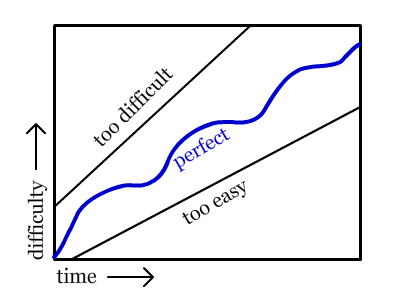You don’t have to create a fully fledged game for users to be able to engage and interact with an eLearning package. With a bit of creativity, its a pretty simple task to replicate the successes of games by including certain gaming elements. The following steps highlight areas that should be considered in any eLearning package. We know from experience and from discussions with students and academics that competition is rife in an educational setting. On the most basic level a student will likely compare results and marks against there own to help engage where they are at on the subject. Adding certain gaming elements can be used to help them in much the same way but before they’ve finished, so then they can see more clearly how they are progressing and where their strengths and weaknesses are. And if the platform allows, can compare and compete with colleagues on the fly.
Develop a challenge
A challenge should be a curve and its a trade off with difficulty and time. If something starts off too difficult, new users will be put off and find it hard to learn. Whereas if its too easy then users get bored and again find it harder to learn.
As well as this an ongoing balance to always keep the user challenged without making it feel impossible is something that user testing before releasing it for wider use will help with.
Also a user is more likely to try and overcome a challenge more if there are rewards on offer as discussed in more detail below.
Tie learning objectives with challenges
Tie challenges and interactions to learning objectives so the user will not feel like doing something that might be a little difficult not worth their time. And possibly add to these learning objectives as they progress to new information.
This will provide a new challenge that will grab their attention and encourage users to continue, especially if the eLearning package is quite big with a lot of content.
Give feedback throughout
Its important for users to know where they stand. Learning something and not having any idea if its actually stuck is unnecessary for any eLearning package. Its easy to provide ongoing feedback to users through simple quizzes or a more complex interaction to help test their new knowledge. The important thing is to provide meaningful feedback… sometimes telling the user they have chosen the correct answer is not enough, what if they guessed the answer?
Feedback should be given to include at least a little feedback to reinforce the correct answer and even more advice and feedback for incorrect answers. Maybe even tell the user to go learn more and revisit previous content before continuing.
Include scoring to aid repeated engagement
Another simple way to create engagement is the inclusion of ongoing scoring or grading based on their tests and how they completed certain tasks. Be careful not to make this too negative. When something is incorrect or the user scored poorly then they don’t need to be shown how badly they did with a score, it would be more helpful to give detailed feedback. But when they succeed, show them there score and match it against something like a leaderboard or top scorers so they know where they stand. This would encourage them to repeat and therefore improve their knowledge on the subject further to also improve their scores.
Reward user when they succeed
There are various ways to reward users when they do well. The important thing is to reward their success. Its a good feeling when you earn something, even if its just at the end once you’ve completed a course. You have something to show for it which can only be positive. You can show a reward by simply including a graphic and animate it. Such as a trophy or badge or thumbs up icon. Anything that help reinforce that the user has done something really well and they are on track. It helps to maintain their learning and immediately removes doubt in their minds if they are unsure of what they just learned.
Add risk and rewards, rules and goals
You can include a simple points system but depending on the subject you can get quite creative with this by including rankings, leaderboards, grades, percentages, timers, badges and printable certificates. Depending on how successful a user was, the rewards could be different. And you can even show what they earn if they can better a previous score. Imagine a certificate at the end which shows their name and a score or grade, by encouraging them to do it again they can try for the best mark possible before printing that certificate! The important thing is your giving them a reason to go through the content again, possibly in a different way. And we all know that the more you try to learn something, the more likely it will stick and be recalled later.
Recommended Lynda course: Gamification of Learning with Karl Kapp
View other blog posts from this series:
Series intro: 5 Highly Effective Strategies For Creating Engaging Elearning
1/5 Build a compelling visual experience
2/5 Add meaningful interactions
4/5 Engage more users with video
5/5 Add fun gaming elements

